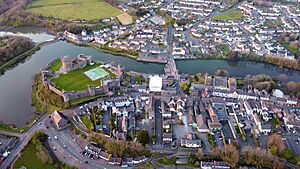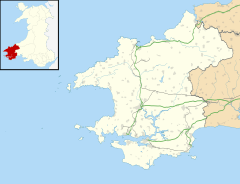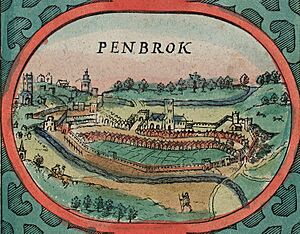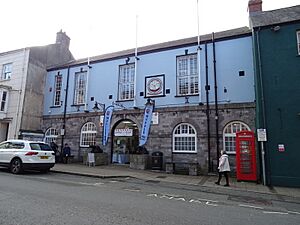Pembroke, Pembrokeshire facts for kids
Quick facts for kids Pembroke
|
|
|---|---|
 Aerial view of Pembroke Castle and Main Street |
|
| Population | 7,552 (2011 census) |
| OS grid reference | SM985015 |
| Community |
|
| Principal area | |
| Ceremonial county | |
| Country | Wales |
| Sovereign state | United Kingdom |
| Post town | PEMBROKE |
| Postcode district | SA71 |
| Dialling code | 01646 |
| Police | Dyfed-Powys |
| Fire | Mid and West Wales |
| Ambulance | Welsh |
| EU Parliament | Wales |
| UK Parliament |
|
| Welsh Assembly |
|
Pembroke (pronounced PEM-bruuk) is a historic town in Pembrokeshire, Wales. It is home to about 7,552 people. The name Pembroke comes from the Welsh words Pen (meaning 'head' or 'end') and bro (meaning 'region' or 'land'). This might mean 'Land's End' or 'headland'.
Pembroke is famous for its many old buildings and its strong town walls. The most well-known landmark is Pembroke Castle. This castle is special because it was the birthplace of Henry VII of England, who later became King of England.
Contents
History of Pembroke
Pembroke Castle's Story
Pembroke Castle is a large, old stone fortress. It was built by the Normans in 1093. The castle sits on a piece of land surrounded by water on three sides. It was once the home of powerful leaders called the Earls of Pembroke. King Henry VII of England was born here.
The town of Pembroke grew around the castle. Around 1254, the town got strong defensive walls. Parts of these walls still stand on their original foundations today. Many of the town's old medieval land plots also remain, divided by ancient stone walls.
Monkton Priory and Old Buildings
Across the river from the castle is Monkton Priory. It was founded in 1098 by Arnulf de Montgomery. This old church has many original Norman walls. Monkton Hall, near the Priory, is thought to be the oldest house in Pembrokeshire. It might have been a guesthouse for visitors to the Priory.
The first stone building in Pembroke town was a defensive tower. It is now called the Medieval Chapel. This building was later used as a church. It even served as a brewery for a short time. During the English Civil War, it was a headquarters for Oliver Cromwell during the Siege of Pembroke.
Riverside Activities and Industry
The main bridge in town crosses the River Pembroke. This bridge also acts like a dam, creating a large millpond. The first bridge here had a tide mill, which used the river's tides to grind grain. The last mill building burned down in 1956.
Near the castle, along the Pembroke River, you can find signs of old industries. There are old quarries and slipways where wooden ships were built. This was before the bigger industrial dockyard was built in Pembroke Dock. There is even a very old dry dock in what was called Hancock's Yard.
During the English Civil War, the area was mostly controlled by forces loyal to Parliament. They wanted to stop communication with Ireland. Later, at Pennar Flats, there was an early base for testing submarines.
The ferry port of Pembroke Dock is about 3 miles (4.8 km) northwest of Pembroke. It was started in 1814.
Pembroke's Location
Pembroke town is on a limestone peninsula in South Pembrokeshire. It is next to the estuary (where a river meets the sea) of the River Cleddau. The town is surrounded by forests and farms. It is 8 miles (13 km) south of Haverfordwest, the county town.
The town's main street, called Main Street, is the only street inside the original Pembroke town walls. Outside the walls, new neighborhoods have been built. The village of Monkton is also part of the Pembroke area. In 2001, the population of the community was 7,214.
When you combine Pembroke and Pembroke Dock, their total population is 15,890. This makes it one of the biggest population centers in West Wales.
How Pembroke is Governed
Local and National Representation
Pembroke is part of the Carmarthen West and South Pembrokeshire area for the Welsh Parliament (called the Senedd). It is also part of the Mid and South Pembrokeshire area for the UK Parliament in London.
Your local representative in the UK Parliament, called a MP, is Henry Tufnell. He is a member of the Labour Party.
Town Council and Changes Over Time
Pembroke has been an old town with its own rules since at least 1168. It used to cover a larger area, including Pembroke Dock. As Pembroke Dock grew, the town council started holding meetings in both places.
In 1974, Pembroke became part of a new area called South Pembrokeshire. Then, in 1986, the Pembroke area was split. Pembroke Dock became its own community, and Pembroke Town Council now only covers the old town of Pembroke itself. In 1996, South Pembrokeshire was removed, and the area became part of the re-established Pembrokeshire.
Education in Pembroke
For younger students (ages 3–11), Pembroke has three state schools. Golden Grove CP School teaches in English. Ysgol Bro Penfro provides Welsh-medium primary education. In Monkton, students can go to Monkton Priory CP School.
Older students (ages 11–18) attend Henry Tudor School. This is a large school with about 1,600 students. It also has a sixth form for students aged 16-18. The school was formed in 1972 by combining two older schools. It got its current name in 2018 after new buildings were constructed. Henry Tudor School welcomes students from many local primary schools in the area.
Culture and Community
Pembroke 21C is a community association started in 2004. They run Foundry House as a community centre. They organize the yearly Pembroke Festival and a farmers' market every two weeks. They also produce a newsletter for everyone in town.
Pembroke Rugby Club organizes the town's annual carnival, usually in June. Pembroke Library is in the same building as the Tourist Information Centre. It offers books to borrow and internet access.
Pembroke has "twinned" with other towns. It has been twinned with Bergen, Lower Saxony, Germany, since 1977. It also twinned with Pembroke, Malta, in 2002.
Notable People from Pembroke
- King Henry VII (1457–1509), King of England, born in Pembroke Castle.
- William Lort Mansel (1753–1820), a churchman and Cambridge scholar.
- Emma Leslie (1838-1909), an English writer who died and is buried in Pembroke.
- Frank Goodden (1889–1917), a British aviator and test pilot.
- Mervyn Johns (1899–1992), a Welsh actor for stage, film, and TV.
- W. F. Grimes (1905–1988), a Welsh archaeologist who studied the early history of Wales.
- Daniel Jones (1912–1993), a Welsh composer of classical music.
- John Cooke (1922–2011), a British doctor and Royal Air Force officer.
- Peter Bishop (1953–2022), an English painter and art historian.
- William Bowen (1862–1925), a Welsh international rugby union player.
- Henry Davies (1865–1934), a Welsh jockey and cricketer.
- W. J. A. Davies (1890–1967), a Welsh rugby union player for England.
- Reg Thomas (1907–1946), a Welsh middle-distance runner who competed in the Olympics.
- David Gwynne-James (1937−2011), a Welsh cricketer and British Army officer.
- Scott Gammer (born 1976), a Welsh former professional boxer.
- Jonathan Thomas (born 1982), a Welsh rugby union coach and former player.
Sports in Pembroke
Pembroke Rugby Club plays on Upper Lamphey Road. Their home ground is called Crickmarren. The club plays in WRU Division Five West. A big game for them is often against their local rivals, the Pembroke Dock Harlequins. Famous players like Jonathan Thomas, Dominic Day, and Luke Hamilton have played for Pembroke.
Another local sports team is the football team Monkton Swifts.
Pembroke is also home to Pembroke Cricket Club. They play their home games at the Treleet ground, across from the rugby club. The club has two teams that play in the Pembrokeshire league. Their team colors are green and gold.
Internet Speed in Pembroke
In 2012, Pembroke was known for having some of the slowest internet speeds in the UK. The average download speed was only about 1.6 Mbit/s. This was much slower than the UK average of 12.0 Mbit/s at the time.
However, things have improved! BT's telephone exchange for Pembroke and Pembroke Dock was upgraded in 2014. This brought faster internet technology, called fiber-to-the-cabinet, to the area. The goal was to bring superfast broadband to most of Wales.
More recently, in 2022, a company called Ogi announced plans to bring even faster internet to Pembroke. They are rolling out fiber-to-the-premises technology. This will allow homes to get superfast broadband speeds of up to 1 Gbit/s (1000 Mbit/s).
Images for kids
See also
 In Spanish: Pembroke para niños
In Spanish: Pembroke para niños





